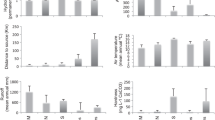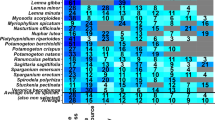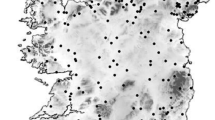Abstract
A series of models was developed using functionally-derived variables (mainly based on morphological attributes of freshwater macrophytes) to predict the trophic status of river and associated channel systems. The models were compared with an existing species-assemblage based procedure for predicting British river trophic conditions (the Macrophyte Trophic Ranking scheme, MTR). We compared sites in cooler temperate conditions (in Scotland) and warmer, sub-tropical conditions (in Egypt). In total, we made measurements of 13 traits from >600 individual plant specimens of 33 species growing at 42 sites (divided into independent input and test site datasets). N status (as annual mean concentration in water of total oxidised nitrogen, TON) was only very poorly predicted by this approach. However, P (as annual mean concentration in water of soluble reactive phosphate, SRP) was better predicted: both by a model based on MTR (r = −0.585, p<0.001), and by models using functional attributes of the macrophyte vegetation. River Trophic Status Indicator (RTSI) models based on ranked plant functional group relationship to river water P concentrations (RTSIFG), or field-measured trait sets of the plants (RTSITR) could also individually explain up to about 34% of the variation in P, both for the total dataset and for subsets from Egypt or Scotland alone or for high v. low-flow sites. Combining both types of RTSI measure produced the most powerful predictive model (r = 0.72, p<0.001), explaining just over half the variability in P.
Similar content being viewed by others
References
Abernethy, V. J. A., 1994. The functional ecology of euhydrophyte communities of European riverine wetland ecosystems. Ph.D. Thesis, Univ. Glasgow: 265 pp.
Agami, M., 1989. Effects of water pollution on plant species composition along the Amal River, Israel. Arch. Hydrobiol. 100: 445–454.
Ali, M. M. & M. E. Soltan, 1996. The impact of three industrial effluents on submerged aquatic plants in the River Nile, Egypt. Hydrobiologia 340: 77–83.
Ali, M. M., A. Hamad, I. V. Springuel & K. J. Murphy, 1995. Environmental factors affecting submerged macrophyte communities in regulated waterbodies in Egypt. Arch. Hydrobiol. 133: 107–128.
APHA (American Public Health Association), 1980. Standard Methods for the Examination of Water and Waste Water. 16th edn. American Public Health Association. New York: 1268 pp.
Barko, J. W., D. Gunnison & S. R. Carpenter, 1991. Sediment interactions with submerged macrophyte growth and community dynamics. Aquat. Bot. 41: 41–65.
Bini, L. M., S. M., Thomaz, K. J. Murphy & A. F. M. Camargo, 1999. Aquatic macrophyte distribution in relation to water and sediment conditions in the Itaipu Reservoir, Brazil. Hydrobiologia 415 (Dev. Hydrobiol. 147): 147–154.
Caffrey, J. M., 1985. A scheme for the assessment of water quality using aquatic macrophytes as indicators. J. Life Sci. R. Dubl. Soc. 5: 105–111.
Caffrey, J. M., 1986. Macrophytes as biological indicators of organic pollution in Irish rivers. In Richardson, D. H. S. (ed.), Biological Indicators of Pollution. Royal Irish Academy, Dublin: 77–87.
Daniel, H. & J. Haury, 1996. Ecology of aquatic macrophytes in an Armorican river (the River Scorff, Southern Brittany, France), application to bioindication. Ecologie (Brunoy) 27: 245–256.
De Lange, L. & J. C. J. Van Zon, 1983. A system for the evaluation of aquatic biotopes based on the composition of the macrophytic vegetation. Biol. Conserv. 25: 273–284.
Demars, B., 1997. Classification des hydrophytes sur la base des traits de l'histoire de vie. Thesis, DEA, Univ. Paris XI and Univ. Glasgow: 25 pp.
Ellenberg, H., 1973. Chemical data and aquatic vascular plant as indicator for pollution in the Moosach river system near Munich. Arch. Hydrobiol. 72: 533–549.
Environment Agency, 1996. Methodology for the assessment of freshwater riverine macrophytes for the purposes of the UrbanWasteWater Treatment Directive. Version 2. Environment Agency, Bristol, U.K: 34 pp.
Gauch, H. G. 1982. Multivariate analysis in community ecology. Cambridge University Press, Cambridge, U.K: 298 pp.
Gordon, A. D., 1981. Classification: Methods for the Exploratory Analysis of Multivariate Data. Chapman & Hall, London: 193 pp.
Grime, J. P., J. G. Hodgson & R. Hunt, 1988. Comparative plant ecology. Unwin Hyman, London, 742 pp.
Haslam S.M. & P.A. Wolseley, 1981. River Vegetation: its Identification, Assessment and Management. Cambridge University Press, Cambridge.
Haslam, S. M., J. P. C. Harding & D. H. N. Spence, 1987. Methods for the use of aquatic macrophytes for assessing water quality 1985–86. In Methods for Examination of Waters and Associated Materials. HMSO, London.
Haury, J., 1996. Assessing functional typology involving water quality, physical features and macrophytes in a Normandy river. Hydrobiologia 340: 43–49.
Haury, J. & M.-C. Peltre, 1993. Intérêts et limites des 'indices macrophytes' pour qualifier la mésologie et la physico-chimie des cours d'eau: exemples armoricains, picards et lorrains. Annls. Limnol. 29: 239–253.
Haury, J., M.-C. Peltre, S. Muller, M. Tremolieres, A. Dutartre & M. Gherlesquin, 1996). Macrophyte indices for the assessment of stream water quality in France: preliminary proposals. Ecologie (Brunoy) 27: 233–244.
Hills, J. M., K. J. Murphy, I. D. Pulford & T. H. Flowers, 1994. A method for classifying European riverine wetland ecosystems using functional vegetation groups. Funct. Ecol. 8: 242–252.
Holmes, N. T. H., 1983. Focus on Nature Conservation. 4. Typing British Rivers according to their flora. Nature Conservancy Council, Shrewsbury, U.K.
Husak, S. & V. Vorechovska, 1996. Stream vegetation in different landscape types. Hydrobiologia 340: 141–145.
Jongman, R. G. H., C. J. F. Ter Braak & O. F. R. van Tongeren, 1995. Data Analysis in Community and Landscape Ecology. Cambridge University Press, Cambridge: 299 pp.
Kohler, A., 1975. MacrophytischeWasserpflanzen als Bioindikatorn für Belastungen von Fliessgewässerökosystemen. Verh. Ökologie, Wien 3: 255–276.
Kohler, A. & S. Schiele, 1984. Versauerungsresisternz submerser Makrophyten in Gewässerversauerung in der Bundesrepublik Deutschland. Matierialien 1/84. Erich Scmidt Verlag, Berlin: 353–369.
Krzanowski, W. J. & Y. T. Lai, 1988. A criterion for determining the number of groups in a data-set using sum-of-squares clustering. Biometrics 44: 23–34.
Leishman, M.R. & M. Westoby, 1992. Classifying plants into groups on the basis of associations of individual traits - evidence from Australian semi-arid woodlands. J. Ecol. 80: 417–424.
McIntyre, S., S. Lavorel & R. M. Tremont, 1995. Plant lifehistory attributes: their relationship to disturbance response in herbaceous vegetation. J. Ecol. 83: 31–44.
Moore, B. C., J. E. Lafer & W. H. Funk, 1994. Influence of aquatic macrophytes on phosphorus and sediment porewater chemistry in a freshwater wetland. Aquat. Bot. 49: 137–148.
Murphy, K. J., B. Rørslett & I. Springuel, 1990. Strategy analysis of submerged lake macrophyte communities: an international example. Aquat. Bot. 36: 303–323.
Newbold, C. & N. T. H. Holmes, 1987. Nature conservation: water quality criteria and plants as water quality monitors. Water Pollut. Contr. 86: 345–364.
OECD, 1982. Eutrophication of waters: monitoring, assessment and control. Organisation for Economic Cooperation and Development, Paris, France.
Payne, R. W., P. W. Lane, P. G. N. Digby, S. A. Harding, P. K. Leech, G. W. Morgan, A. D. Todd, R. Thompson, G. Tunnicliffe Wilson, S. J. Welham & R.P. White, 1993. GENSTAT 5 Release 3 - Reference Manual. Clarendon Press, London: 796 pp.
Robach, F., S. Merlin, T. Rolland & M. Tremolieres, 1996. Ecophysiological approach of water quality bioindicating using aquatic plant materials: the role of phosphorus. Ecologie (Brunoy) 27: 203–214.
Schmedtje, U. & F. Kohmann, 1987. Bioindication by macrophytes - can macrophytes indicate saprobity? Arch. Hydrobiol. 109: 455–469.
Spink, A. & K. J. Murphy, 1997. Distribution and environmental regulation of Batrachian Ranunculus in British rivers. Arch. Hydrobiol. 139: 509–525.
Springuel, I. & K. J. Murphy, 1991. Euhydrophyte communities of the River Nile and its impoundments in Egyptian Nubia. Hydrobiologia 218: 35–47.
Standing Committee of Analysts, 1987. Methods for the use of aquatic macrophytes for assessing water quality 1985–86. HMSO, London.
Author information
Authors and Affiliations
Corresponding author
Rights and permissions
About this article
Cite this article
Ali, M.M., Murphy, K.J. & Abernethy, V.J. Macrophyte functional variables versus species assemblages as predictors of trophic status in flowing waters . Hydrobiologia 415, 131–138 (1999). https://doi.org/10.1023/A:1003833419359
Issue Date:
DOI: https://doi.org/10.1023/A:1003833419359




